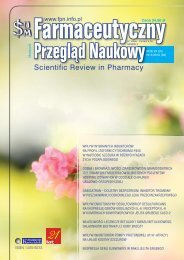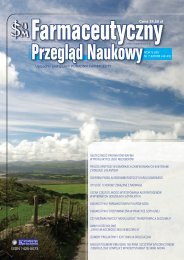Pokaż caÅy numer - FPN - Farmaceutyczny PrzeglÄ d Naukowy
Pokaż caÅy numer - FPN - Farmaceutyczny PrzeglÄ d Naukowy
Pokaż caÅy numer - FPN - Farmaceutyczny PrzeglÄ d Naukowy
Create successful ePaper yourself
Turn your PDF publications into a flip-book with our unique Google optimized e-Paper software.
copyright © 2009 Grupa dr. A. R. Kwiecińskiego ISSN 1425-5073<br />
ficult to explain why glucose deprivation results in protection<br />
of the newly synthesised collagen against intracellular<br />
degradation.<br />
The endoplasmic reticulum is an organelle where secretory<br />
or membrane proteins are synthesised. Approximately<br />
one-third of all cellular proteins are translocated into the lumen<br />
of the ER with its unique oxidising and Ca2+-rich environment,<br />
where post-translational modification, folding and<br />
oligomerisation of nascent proteins occur before they are<br />
translocated to their final destination. Correct folding is an<br />
important factor which allows translocation of protein molecules<br />
to specific subcellular compartments, extracellular<br />
matrix or to biological fluids [20-22]. The folding process is<br />
regulated by a group of proteins, referred to as chaperones<br />
[23]. ER molecular chaperones and folding enzymes associate<br />
with the newly synthesised, unfolded and/or incompletely<br />
glycosylated proteins to prevent their aggregation and<br />
help them to fold and assemble correctly [21,22]. In some<br />
instances, they function even in the refolding of denatured<br />
proteins [19].<br />
It is known that collagen folding depends on the hydroxylation<br />
of prolyl residues to achieve sufficient amounts of<br />
hydroxyprolyl residues to form a stable triple helical structure.<br />
Properly folded collagen is secreted extracellularly and<br />
serves as a substrate in the process of fibrogenesis. Underhydroxylated<br />
collagen is unable to form a stable triple helical<br />
structure and cannot be secreted from the synthesising cell.<br />
It is degraded by the intracellular proteolytic system [24].<br />
Many stress conditions, such as glucose deprivation, reduces<br />
the folding process which results in the accumulation<br />
of unfolded/misfolded proteins within the cell [25,26]. The<br />
accumulation of unfolded proteins activates the so called<br />
“unfolded protein response”, which enhances cell survival<br />
by limiting the accumulation of unfolded or misfolded proteins<br />
in the ER [25,26]. Molecular chaperones are induced in<br />
these conditions, bind to unfolded/misfolded proteins, and help<br />
them to be folded or refolded correctly [27]. An integral component<br />
of the cellular response to environmental stress is the<br />
expression, usually by de novo protein synthesis, of stress-associated<br />
polypeptides termed oxygen-regulated protein [27,28] .<br />
Several authors have reported that glucose deprivation<br />
results in stimulation of protein degradation [1,6] and that<br />
oxygen or glucose deprivation increases free radicals, which<br />
in turn, oxidise proteins that are recognized and actively degraded<br />
by proteasomes [1]. It is apparent from our results<br />
that collagen (at least in our experimental conditions) is protected<br />
against proteolysis, induced by glucose-deprivation.<br />
This phenomenon is accompanied by an increase in the expression<br />
of ORP150 – a chaperon, which protects intracellular<br />
proteins against degradation. The appearance of ORP<br />
150 in glucose deprived cultures coexisted with an increase<br />
of gelatinolytic activity. Despite glucose shortage reduces<br />
collagen synthesis, the increased expression of ORP150<br />
may reduce the degradation of newly synthesised protein<br />
and protect the cell culture against a massive loss of collagen.<br />
References<br />
1. Weih M et al. Proteolysis of oxidized proteins after oxygen-glucose<br />
deprivation in rat cortical neurons is mediated<br />
by the proteasome. J Cereb Blood Flow Metab<br />
2001; 21:1090-1096.<br />
2. Yoshida H. ER stress and diseases. FEBS J 2007;<br />
274:630-658.<br />
3. Flores-Diaz M et al. A cellular UDP-glucose deficiency<br />
causes overexpression of glucose/oxygen-regulated proteins<br />
independent of the endoplasmic reticulum stress<br />
elements. J Biol Chem 2004; 279: 21724-21731.<br />
4. Cechowska-Pasko M, Pałka J, Bańkowski E. Glucosedepleted<br />
medium reduces the collagen content of human<br />
skin fibroblast cultures. Mol Cell Biochem 2007;<br />
305:79-85.<br />
5. Bilińska B, Cervinka M, Chadzińska M et al. The cell<br />
and tissue culture (in Polish). PWN. Warszawa 2004.<br />
6. Libby P, O'Brien KV. The role of protein breakdown in<br />
growth, quiescence, and starvation of vascular smooth<br />
muscle cells. J Cell Physiol 1984; 118:317-323.<br />
7. Matsushita K et al. Marked, sustained expression of a<br />
novel 150-kDa oxygen regulated stress protein, in severely<br />
ischemic mouse neurons. Mol Brain Res 1998;<br />
60: 98–106.<br />
8. Tsukamoto Y et al. 150 kDa oxygen regulated protein<br />
(ORP150) is expressed in human atherosclerotic plaques<br />
and allows mononuclear phagocytes to withstand cellular<br />
stress on exposure to hypoxia and modified LDL. J<br />
Clin Invest 1996; 98: 1930–1941.<br />
9. Tsukamoto Y et al. Expression of 150 kDa oxygen-regulated<br />
protein (ORP150), a new member of the HSP70<br />
family, in human breast cancers. Lab Invest 1998; 78:<br />
699–706.<br />
10. Cechowska-Pasko M, Bańkowski E, Chene P. The effect<br />
of hypoxia on the expression of 150 kDa oxygenregulated<br />
protein (ORP 150) in HeLa cells. Cell Physiol<br />
Biochem 2006; 17:89-96.<br />
11. Cechowska-Pasko M, Bankowski E, Chene P. Glucose<br />
effect on the expression of 150 kDa oxygen-regulated<br />
protein in HeLa cells. Biochem Biophys Res Commun<br />
2005; 337:992-997.<br />
12. Easton DP, Kaneko Y, Subjeck JR. The Hsp 110 and Grp<br />
170 stress proteins: newly recognized relatives of the<br />
Hsp 70s. Cell Stress Chaperones 2000; 5: 276-290.<br />
13. Fenwick SA et al. 96-well plate-based method for total<br />
collagen analysis of cell cultures. Biotechniques 2001;<br />
30:1010-1014.<br />
14. Koyano Y, Hämmerle H, Mollenhauer J. Analysis of 3Hproline-labeled<br />
protein by rapid filtration in multiwell<br />
plates for the study of collagen metabolism. Biotechniques<br />
1997; 22:706-716.<br />
15. Peterkofsky B, Diegelmann R. Use of a mixture of proteinase-free<br />
collagenases for the specific assay of radioactive<br />
collagen in the presence of other proteins. Biochemistry<br />
1971; 10:988-994.<br />
16. Schneir M, Ramamurthy N, Golub L. Skin collagen metabolism<br />
in the streptozotocin-induced diabetic rat. Enhanced<br />
catabolism of collagen formed both before and<br />
during the diabetic state. Diabetes 1982; 31:426-431.<br />
37
















